Dramatic Vocalise Database
Giacomo Puccini (1858–1924)
Madama Butterfly (1904)
Puccini chose as the source of his libretto for Butterfly a story by John Luther Long, first appearing in an American magazine and then snapped up by the playwright David Belasco. The play achieved so much popularity that Belasco took the production to London, where it was that Puccini saw it.1 As a play, Butterfly never had much merit and today seems antiquated. Puccini chose the subject because he was moved by the play when he saw it in London, even though he understood almost no English. The setting of the play, and of the later opera, is a Japan redolent of cherry blossoms, much like in Iris—a Japan that perhaps never existed. It was also a Japan that neither Mascagni nor Puccini would ever visit.
Madama Butterfly, like Iris before, includes dramatic vocalization. In the first act an offstage women’s chorus—Butterfly’s family and friends coming to celebrate her wedding—sings the word “Ah!” Goro, a marriage broker, comments on the offstage women’s chorus, equating it with the sound of leaves in the wind:
Ecco. Son giunte al sommo del pendio. Già del femmineo sciame qual di vento in fogliame s’ode il brusìo.2
[Here they are! They’ve reached the top of the hill. Already you can hear the swarm of women like leaves in the wind.]
Following its wordless exclamations the chorus sings, “Ah! Quanto cielo! Quanto mar!” [“Ah! What a sky! What a sea!”] 3
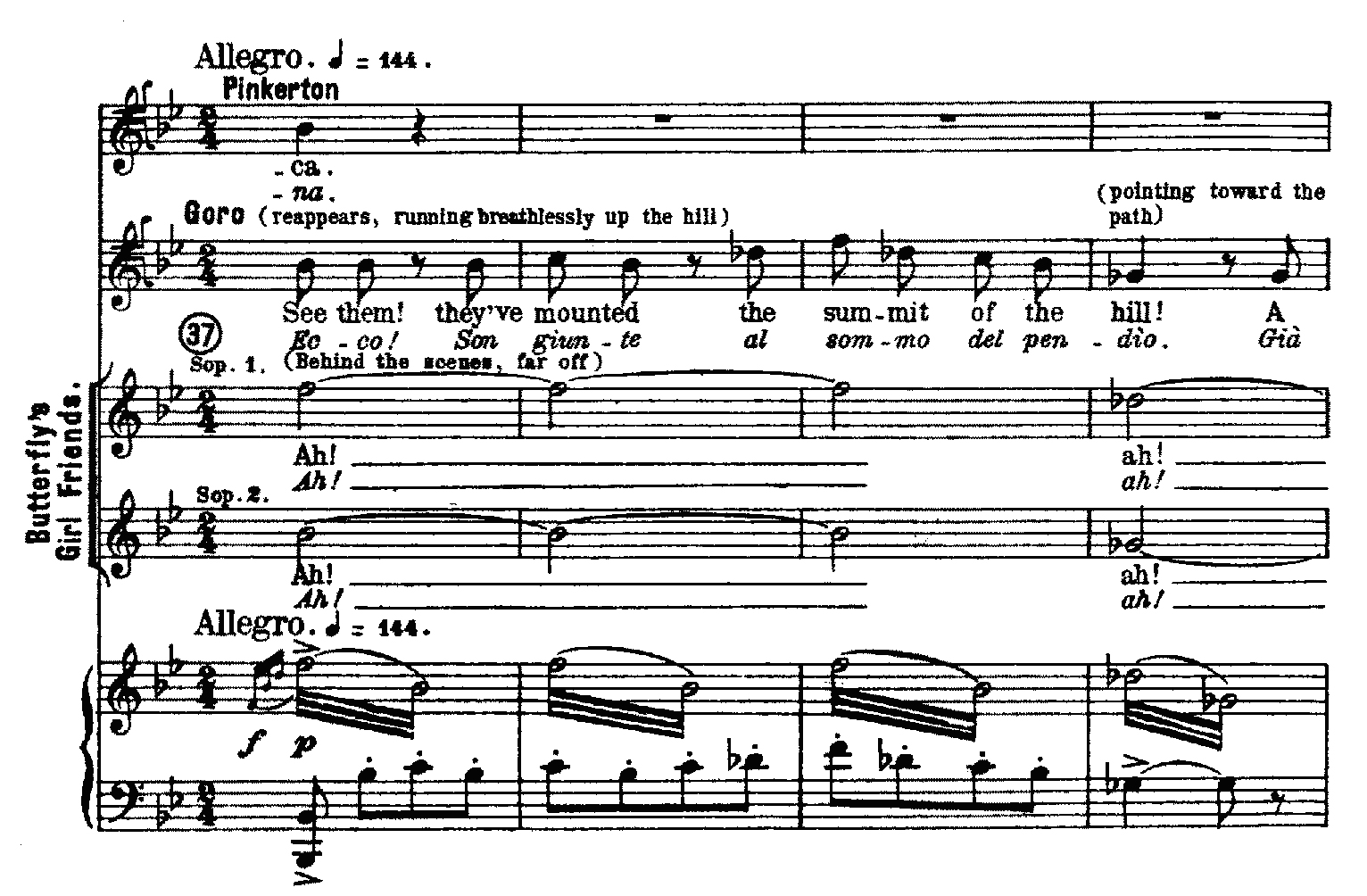
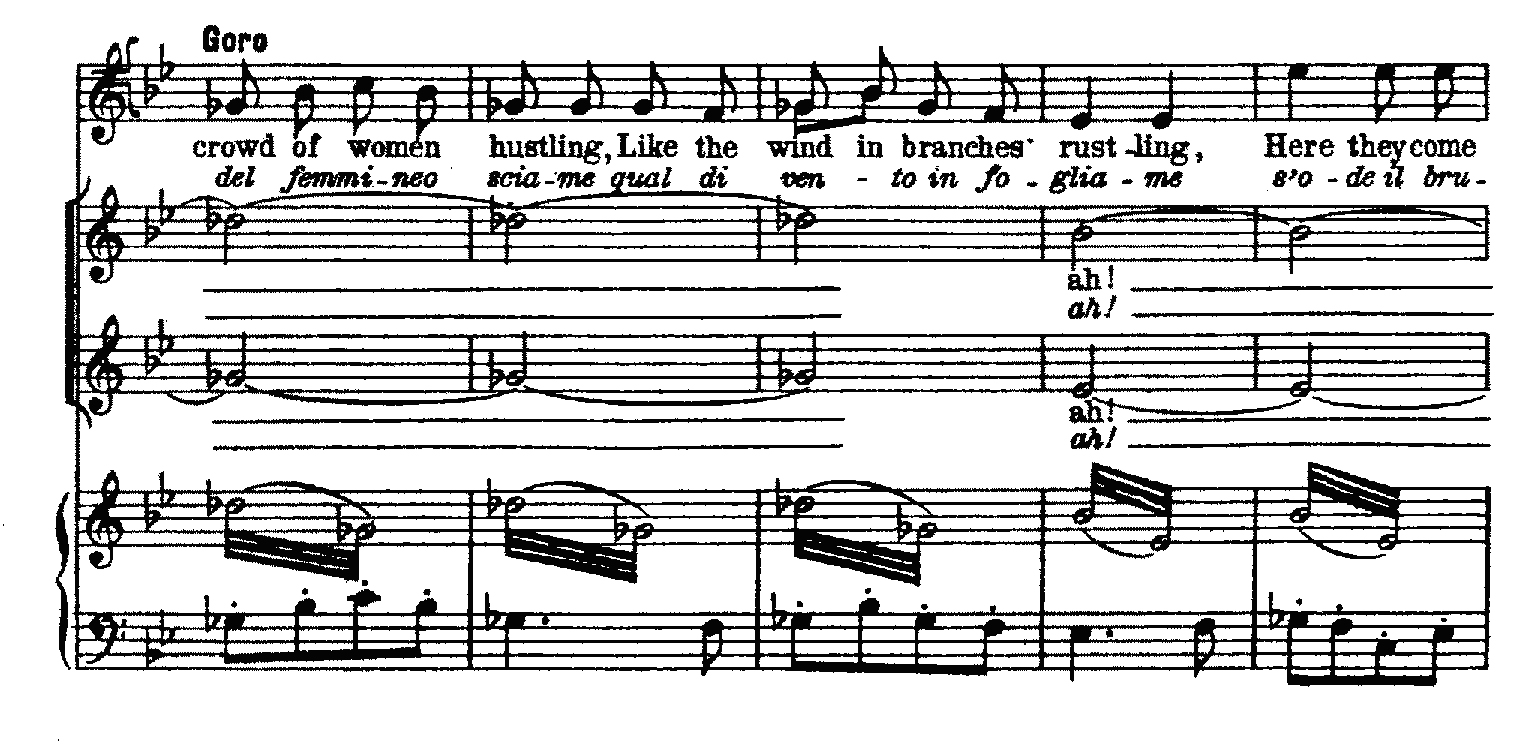
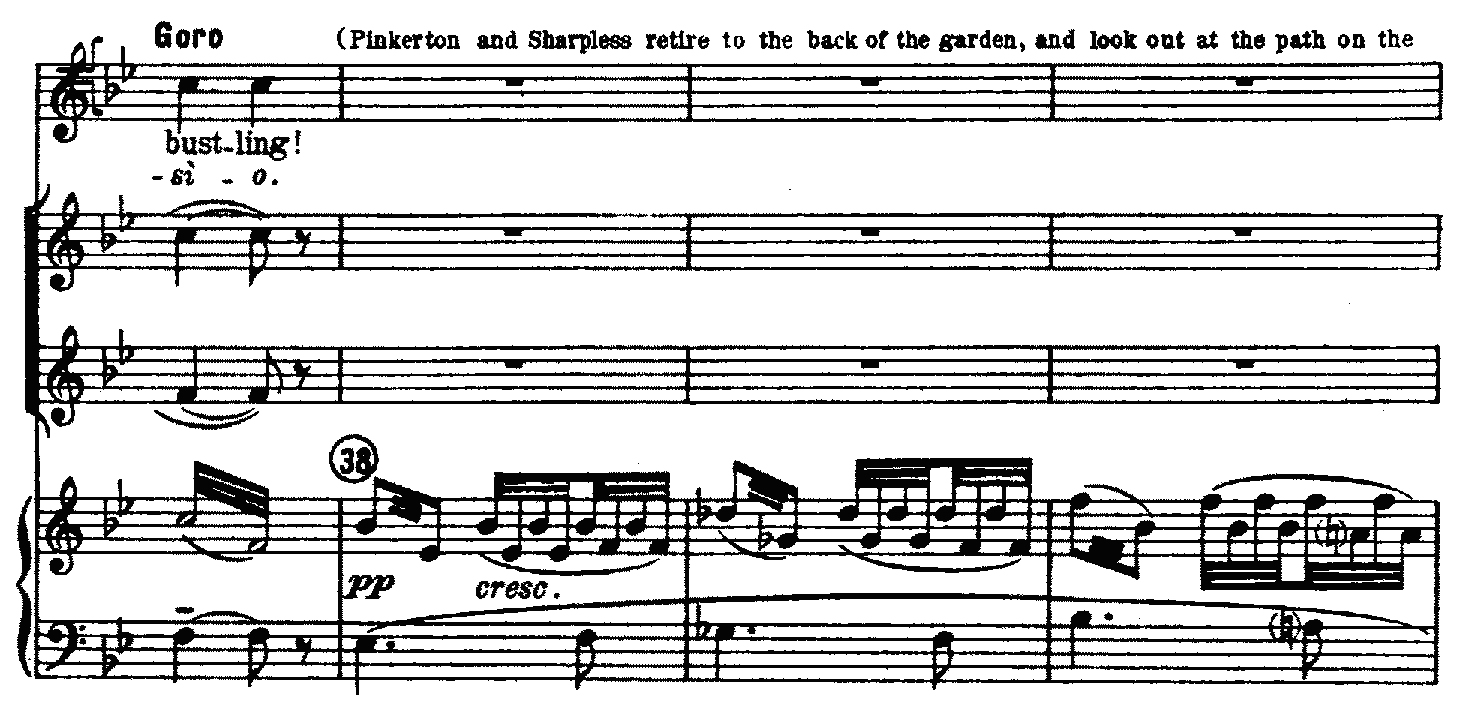
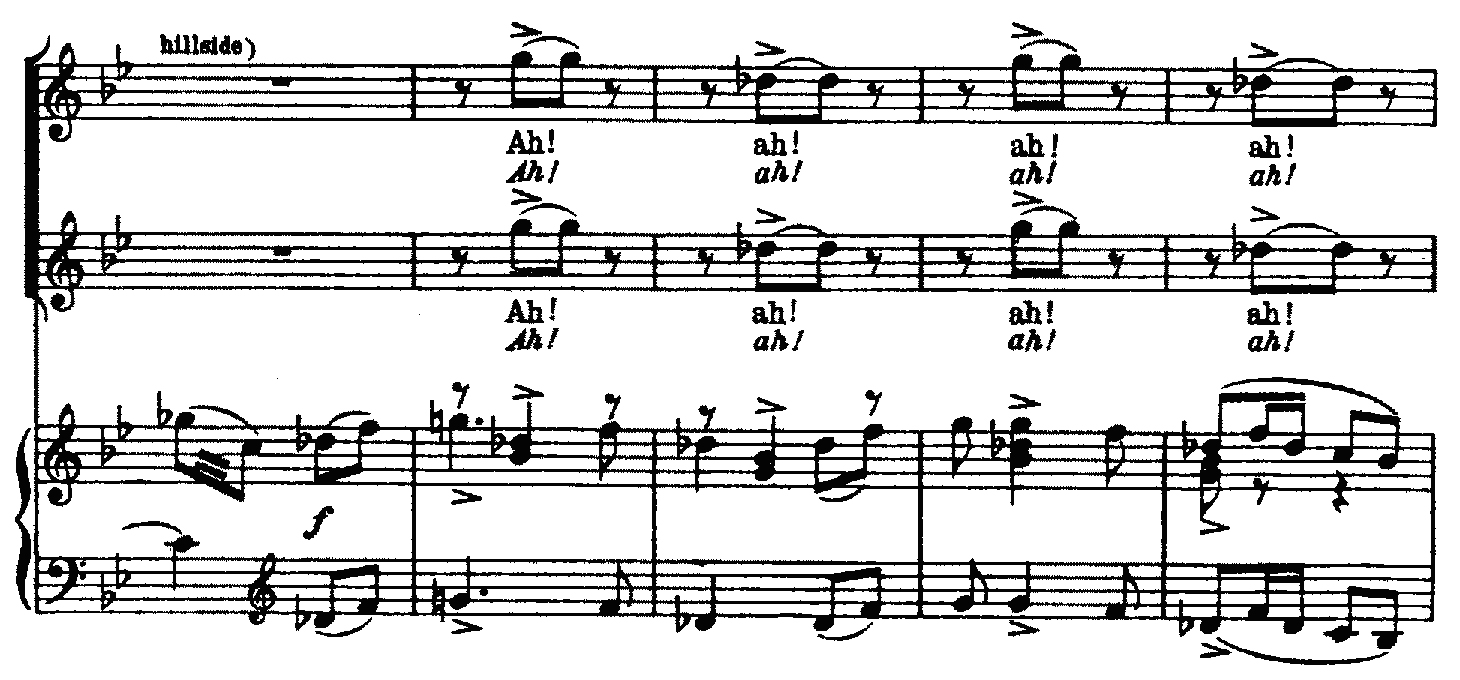


Puccini, Madam [sic] Butterfly, act 1
4The offstage women’s chorus, marked in the full score as interno, lontano [interior, distant], accompanies Goro’s description with its vocalizations. Dramatic vocalization, and its association with “wind,” was previously encountered in Verdi’s Rigoletto. Its association with the “sea” will be found again with Debussy, and other composers. Yet, considering that the chorus is phenomenal, that Goro refers to the offstage singing as that of the chorus of women soon to appear onstage, this serves poorly as an example of dramatic vocalization. Instead it is the “humming chorus,” the coro muto at the end of the first half of act 2, which is the better example of dramatic vocalization.
Puccini obviously gave much thought to all the particulars of the so-called coro muto of Madama Butterfly. While still in the preparatory phase of the libretto, he wrote to Luigi Illica, librettist of Iris and co-librettist of Butterfly with Giuseppe Giacosa:
Ti raccomando l’ultimo quadro e pensami a quell’intermezzo, per servirmi del coro: bisogna trovare qualcosa di buono. Voci misteriose a bocca chiusa (per esempio). Non so cosa vorrei, ma ci vuole qualcosa, e questo qualcosa lo troverai tu, ne sono certo. A presto dunque.5
[I recommend to you the last scene and I am thinking of using the chorus in the intermezzo: it will be necessary to find something good. Mysterious voices a bocca chiusa, for example. I do not know what I would want, but I want something, and this something you will find, I am certain. See you soon.]
Puccini strikes a tactful tone when he puts the responsibility for this innovation in the hands of his librettist when, after all, he is in fact suggesting the solution himself.
This experiment had already been used in Rigoletto and Iris. However, in those cases the a bocca chiusa chorus has a relatively precise meaning: in Rigoletto the voices reproduce the sound of the wind; in act 2 of Iris the soprano geisha hums a lament a bocca chiusa foreshadowing Iris’s tragic fate; in act 3 the choral humming accompanies the moment of Iris’s death and transfiguration, signifying the supernatural.
The chorus in Butterfly does not have a naturalistic or directly obvious reference—it is interno, lontano, a bocca chiusa [inside, at a distance, humming]. We do not know where it comes from, who sings it, or what it denotes. No one has yet understood the absolutely originality of the abstract character of the a bocca chiusa chorus in this opera.6
Puccini was convinced of the greatness of his opera. On 29 August 1903, he wrote to Giulio Ricordi, “there remains the Japanese Mademoiselle, but for Parigi I must orchestrate act 2 right away. Now there remains very little composition for me. I have finished the famous intermezzo that seems very good to me.” 7 On 3 September 1903, Puccini communicated to Illica, “the noted intermezzo is finished, and I am glad to have made something good. Indeed I think I can say I have surpassed myself. I have made the ‘berceuse’ and am at the trio of Sharpless–Pinkerton–Suzuki.” 8 Let us examine this scene, which Puccini himself thought so remarkable.
In the first place, one should note the position of the intermezzo: Sharpless has just torn from Butterfly the ideal of her American husband by suggesting she marry Yamadori, one of her suitors, instead. At first Butterfly remains immobile, as if struck by death [“come colpita a morte”], but then reacts triumphantly [“trionfalmente”], introducing her son to the American consul. The tension has reached its maximum degree. The theatrical parabola is moving toward a conclusion that still has three possible solutions: Pinkerton does not return; Pinkerton returns and loves her; Pinkerton returns and does not love her. Until Pinkerton’s arrival we are still left with the first conclusion. The cannon shot in the harbor and Pinkerton’s return seem to give reason for the incredible confidence of Butterfly: “Trionfa il mio amor! / La mia fe’ trionfa intera! / Ei torna e m’ama!” [“Triumphant is my love! / My faith has triumphed completely! / He returns and loves me!”] The drama could still turn out to be a reconciliation of Butterfly with Pinkerton, especially in light of the little boy, but the words of Sharpless disabuse the audience of this possibility. Sharpless fails to complete reading the letter that would reveal the truth, instead putting it into his pocket. In addition, one cannot forget that the opera carries the subtitle “tragedia giapponese.”
Fausto Torrefranca defines the coro muto as sounding like a childlike language or an orchestral stammer, while Claudio Casini asserts that the melody of the chorus a bocca chiusa brings “the grace of a barcarole into the foreshadowing of the terrible announcement.” 9 Mosco Carner, along the same lines, adds:
In Belasco, Butterfly’s night vigil caught the imagination of all spectators; Puccini’s music has rendered it one of the most poetic in all opera. This nocturne is as inspired a piece as ever sprang from the composer’s head and I venture to suggest that it was sparked off, not by the “Letter” scene where we first meet it, but by this final scene. Even a lullaby can be read into it—possibly suggested to Puccini by the gradual falling asleep of the child and the nurse—witness the gently rocking ostinato, ppp, on the flutes and the muted strings pizz. And the lulling wordless melody hummed by a chorus offstage, a melody instinct with the simplicity of a folk-song.10
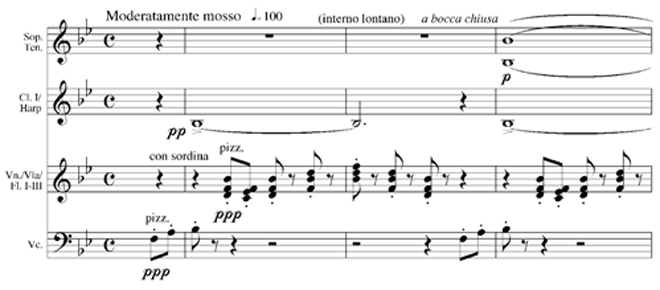

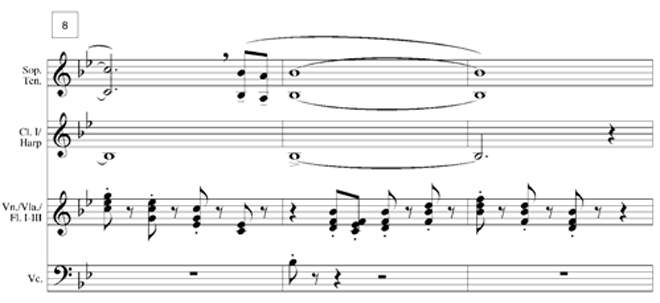
Puccini, Madama Butterfly, act 2, “Humming Chorus,” mm. 1–10
11The following are stage directions given in the score that accompany this scene:
Butterfly conduce il bambino presso lo shosi, fa tre fori nello shosi: uno alto per sè, uno più basso per Suzuki ed il terzo ancor più basso pel bimbo, che fa sedere su di un cuscino, accennandogli di guardare attento fuori del foro preparatogli. Suzuki dopo aver portato le due lampade vicino allo shosi, si accoscia e spia essa pure all’esterno. Butterfly si pone innanzi al foro più alto e spiando da esso rimane immobile, rigida come una statua; il bimbo, che sta fra la madre e Suzuki, guarda fuori curiosamente. È notte; I raggi lunari illuminano dall’esterno lo shosi. Il bimbo si addormenta, rovesciandosi all’indietro, disteso sul cuscino e Suzuki si addormenta pure, rimanendo accosciata: solo Butterfly rimane sempre ritta ed immobile.12
[Butterfly leads the child to the shosi, and makes three holes in it: a high one for herself, one lower down for Suzuki, and the third lower still for the child, whom she gets to sit down on a cushion, telling him to look carefully out of the hole she made for him. Suzuki, having brought the two lamps over near to the shosi, crouches down and looks out. Butterfly stands in front of the highest hole and looking out, stays quite still, as motionless as a statue; the child, standing between his mother and Suzuki, looks out curiously. It is night; the rays of the moon light up the shosi from the outside. The child falls asleep, sinking down, stretching out on the cushion and Suzuki falls asleep also, remaining near: Butterfly alone remains standing and motionless.]
The decisive role that the coro muto plays within the overall drama of Madama Butterfly is a result of the tension that has accumulated from the beginning. Due to its position in the original version of the opera, it is understandable that Puccini was unwilling to create two further divisions in the second act. The chorus acts as an interlude between the two sections of the second act. In fact, it is much more logical that the extraordinary pathos that accumulates during the course of the opera and is met in full in the intermezzo should be allowed to continue straight through to the conclusion, instead of being separated, deflated by a pause either before or after the coro muto.
Puccini’s argument, as he outlined in a letter to Giulio Ricordi from 1902, was that “The drama must run to its end without interruption: tense, effective, terrible! In dividing the opera into three acts we were courting inevitable failure.” 13 For once, Puccini’s unfailing sense for the balance of acts was disrupted; not only was there a striking disproportion between the lengths of the first and second acts—the former lasting about fifty-five minutes, the latter about ninety minutes—but the second in itself was too long. By the time the opera got to the orchestral interlude, the audience became tired and inattentive, so that much of what followed was received indifferently. In his revision, Puccini went back to the original plan of three acts, concluding the second act with the above-mentioned chorus. This is the form in which the opera is usually produced today.14
In order to define the character of the coro muto it is important to observe not the behavior of Suzuki and the child, but that of the protagonist, Butterfly herself. The chorus does not begin before Butterfly leads the child to the shosi, and makes three holes in it. Butterfly stands in front of the highest hole and looking out, stays quite still, as motionless as a statue. She does not fall asleep like her beloved servant and child, but remains wide awake. The coro muto may allude to either a lullaby or a situation of serene suspense, and, more importantly, it is the moment within a development that, already channeled toward pessimism, now moves toward the ultimate tragedy.
Immobility is a feature of Butterfly’s behavior at moments of greatest stress. After having been renounced by her relatives for her wedding to Pinkerton in act 1, Butterfly is similarly “immovable and speechless, with her face in her hands” [“immobile e muta con la faccia nelle mani”]. In the second act, after Sharpless asks Butterfly her thoughts on whether Pinkerton will return to her, she again remains “immovable, as if hit by death” [“immobile, come colpita a morte”]. Also, when Butterfly hears that Goro has been telling everyone that the paternity of her child is unknown, she stands immobile, “as if turned to stone” [“rimane immobile come impietrita”]. Then, when she comes to know that Pinkerton is alive, she reacts “as if she had received a mortal blow: hardened” [“come se avesse ricevuto un colpo mortale: irrigidita”]. Persuaded to abandon her son, she remains “immovable and calm” [“rimane immobile e calma”]. The tragedy is now complete. We will find Butterfly again immobile when she kneels down in front of the image of the Buddha close to the end of the opera. These extraordinary moments, this recurring psychological leitmotif marks beyond a doubt the growing, repressed anguish. Butterfly always becomes stiff in situations where she is aware of her own troubled existence.
The melody of the coro muto is anticipated in the previous “Letter” scene. It is at the moment in which Sharpless reads the letter to Butterfly, stopping short in the process, and suggesting Yamadori as a potential husband for her, that Butterfly comes to realize the situation, even if she is yet to accept the facts. Additionally, the cell F–A–Bb that opens the coro muto melody permeates the “Letter” scene. This connects these scenes both musically and dramatically, giving a perspective on the meaning of the chorus.
A manipulation of this same basic cell (F–A–Bb) can be seen as the basis for another prominent melodic idea within the opera, that of “The Father’s Suicide” or “Sword” theme, although here the original compass of a fourth is now expanded into a tritone. In act 1 Butterfly alludes to her father’s previous suicide at the bidding of the Emperor. While Butterfly examines the sword her father used to commit the act, this musical theme sounds. It is this same sword that will take the life of Butterfly—the same theme that will accompany her suicide—at the end of the opera.

Puccini, Madama Butterfly, “The Father’s Suicide” or “Sword” Theme
It is possible to see the coro muto in Butterfly as similar in function to the chorus in Greek tragedies. Puccini momentarily suspends the dramatic flow in order to emphasize the emotional situation of the protagonist. Here words would be insufficient to express the horror whose precise development is still unclear, even if all scenic and musical indications point toward the impending tragedy.
One last use of offstage chorus, of dramatic vocalization, occurs at the beginning of act 2, part 2 of Butterfly, immediately following the coro muto. The ship carrying Pinkerton comes into harbor accompanied by “marinai” [“sailors”] (as designated in the score) singing “Oh eh!” [“Heave Ho!”]. Their offstage location is implied by the accompanying score direction “dalla baia, lontanissimi” [“from the bay, very far away”].15


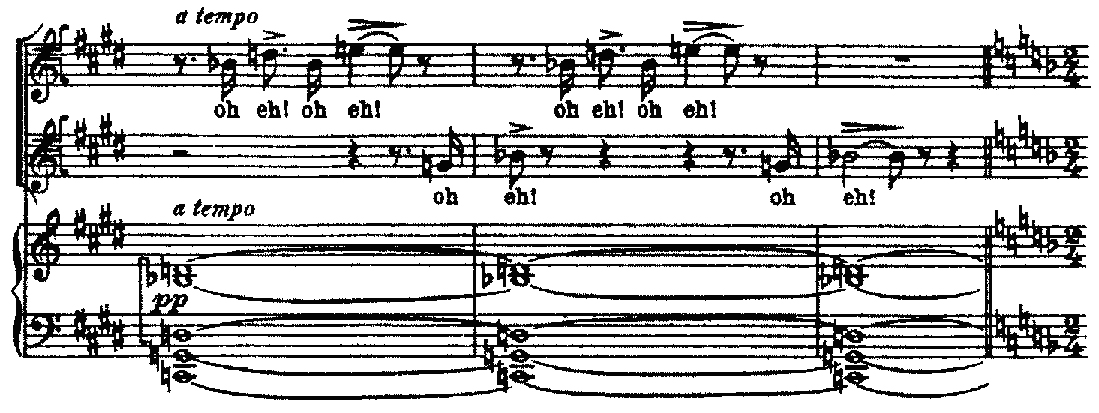
Puccini, Madam [sic] Butterfly, act 2, part 2, mm. 58–66
16Following this excerpt, Puccini includes the score direction, “Rumori di catene, di áncore e di manovre marinaresche” [“Sounds of chains, anchors, and marine maneuvers”].17 The male voices, as opposed to the earlier female chorus, are not those of mystical entities, not sirens or prickly sea-sprites, but instead sailors situated offstage. Their sung text, seemingly meaningless, is nothing new within opera. Two years earlier Debussy had included a similar offstage chorus of sailors in act 1 of his opera Pelléas et Mélisande (1902), the only use of chorus within the entire opera.

Debussy, Pelléas et Mélisande, act 1 18
(Nauman 2009, 64–77)
Examples | Comments |